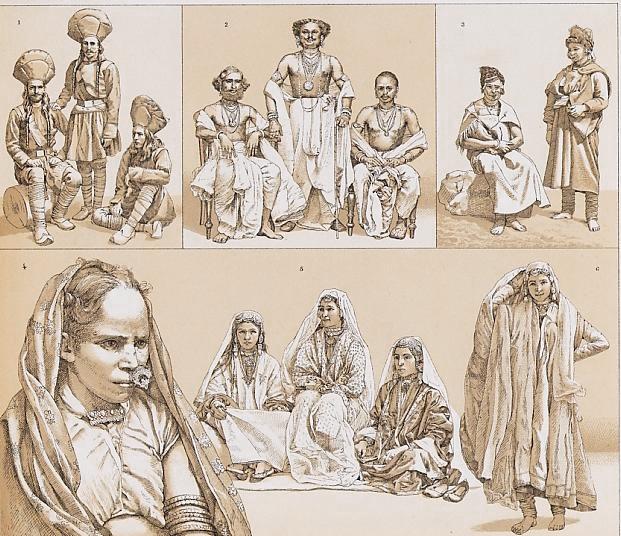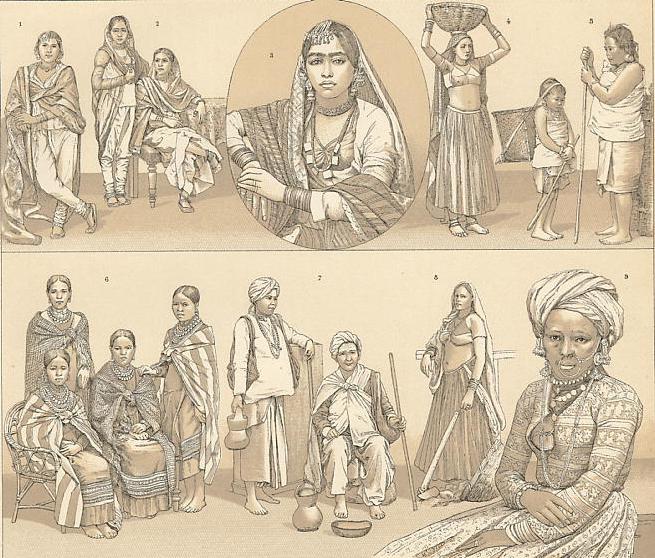



Lithograph prints from the 1876 Racinet set: some views of the "People of India"
Source: ebay, Dec. 2001
While humans have probably occupied portions of India for several hundred thousand years, the racial stocks of the earliest inhabitants, as well as the time and place of their arrival, are not known with certainty. There is considerable debate, for example, over the racial affinities of those who lived in the great urban culture of the Indus Civilization (c. 2600-2000 BC). It was long held that a number of groups, most notably the so-called Aryans, came in successive waves during the decline of this civilization, but more recently even that theory has been questioned because of a lack of convincing archaeological evidence. What is generally accepted, however, is that an early "Aryan" civilization--dominated by peoples with linguistic affinities to peoples in Iran and Europe--came to occupy northwestern and then north-central India over a period from roughly 2000 to 1500 BC and subsequently spread southwestward and eastward at the expense of other indigenous groups. This process was attended by considerable iscegenation, despite caste restrictions; and arguably it is still continuing, although not without considerable opposition from peoples whose own distinctive civilizations had also evolved in early historical times. Among the documented invasions that added significantly to the Indian ethnic mix are those of Persians, Scythians, Arabs, Mongols, Turks, and Afghans. The last and politically most successful of the great invasions--namely, that from Europe--vastly altered Indian culture but had relatively little impact on India's ethnic composition.
"TOP PRINT: Fig. 1. Radjpoutes, soldiers of Cashmere army; 2. Native princess of Orissa; 3. Mountaineers from Koulou region, also called the end of the world, Cashmere; 4. Mina women. The Mina were once known as Pal people - pal being the name for a fortified wall of the type built to link their scattered houses. Later, the Mina became dispersed in the Jaipur region, and adopted the Hindu customs of local djat growers. The Mina wear similar jewellery to that found in the Assam mountains. An original item, though, is the nose-ring that clips on to the upper lip after passing through the nostrils. 5,6. Nautch girls of Cashmere.
CENTER PRINT: 1,2 and 3. Bayaderes from the meridional India; 4, and
8. Koli woman (large caste living in the central and western mountain area
of India); 5. Garro woman and her son; 6. A group of women from the mountains
of Assam. Unlike the uncivilized Garro, these mountain people tend to keep
in contact with the people of the plains, and wear similar clothes to them:
long embroidered and fringed tunics and tartan-like shawls, worn folded
into a square or knotted over the chest. Both sexes wear very crude jewellery,
though the women have adopted the heavy earrings that are a feature of
plains costume; 7 Women on a pilgrimage, wearing cloth turbans and
the white stigmata of their sect on their foreheads. Their necklaces
are made of glass and coral, and their cholis are made of a white fabric.
In the case of the seated lady it has been darkened or torn; this lady
also wears a sash and a coat, knotted at the chest. Woman take all their
cooking utensils with them on pilgrimage, and all along the pilgrims' route
abandoned pots and pans can be found. This is because caste members believe
that the gaze of a non-caste member defiles the pot: if they only suspect
that a pot has been glanced at by a stranger, pilgrims will abandon it.
Pilgrims actually reduce their ration of rice so as to be able to afford
a new pot each day. 9 A Manpouri woman, from Eastern Bengal. She
is a member of one of the lowest castes, the distinguishing feature being
her dark skin.